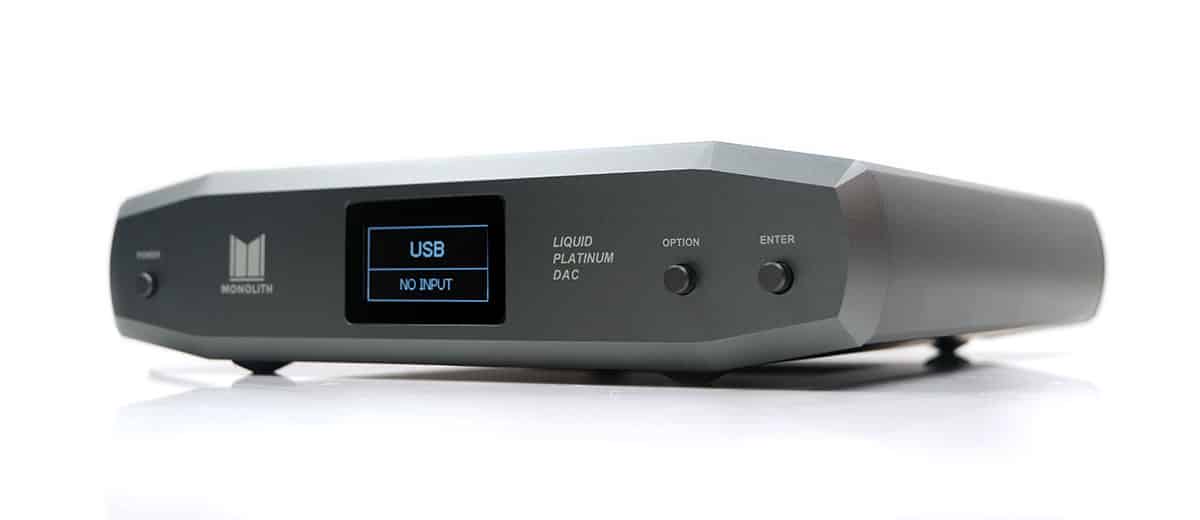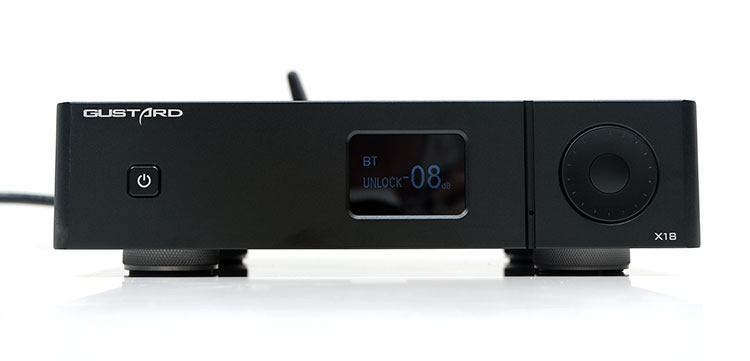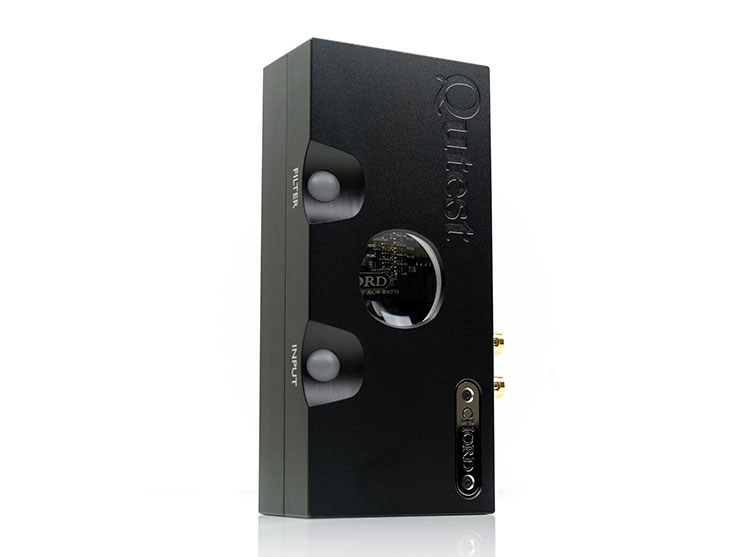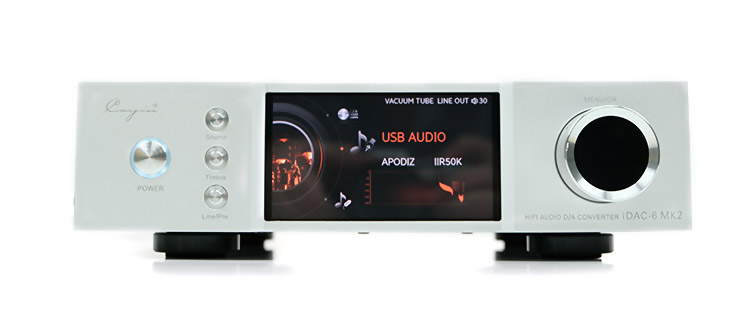Select Comparisons
For our comparison work, an Auris HA-2SE was used as the main amplifier alongside both the Audeze MM-500 and the Meze Empyrean headphones.
Gustard X18
The X18 has a very similar price point and was reviewed a little earlier this year. It is seen as the successor or the next grade up from their popular X16. You can read our full review of the X18 DAC here.
$749
Technical
The X18 instead uses a single ES9038PRO delta-sigma implementation instead of the Liquid Platinum DAC’s single AKM 4499EQ. Both are flagship DAC chipsets from the respective makers, however, the X18 also comes decked with a higher-grade XMOS XU216 compared to the Cavalli’s XU208.
That does make a difference in decoding capability with the combined ES/XMOS digital bridge of the X18 offering up to DSD512 and PCM 32BIT/768kHz compared to 32BIT/384kHz and DSD128. The X18 is also equipped with a BT5.1 module so LDAC at 24BIT/96kHz is added as well as MQA up to 8X.
Both devices offer optical, coaxial, as well as USB digital inputs though the X18 adds additional I²S and AES functionality. Filtering is good on both units in terms of choice with 6 PCM and 2 DSD filters for the Liquid Platinum DAC as opposed to just 3 for the X18. However, the X18 throws in a NOS and OS option which does make more of a difference.
One final feature the X18 has that is missing on the Cavalli is a pre-amp output with variable volume control. The Liquid Platinum DAC only offers a fixed line out though it does offer a few 3 analog outputs as opposed to just 2 on the X18.
Design
Which design you prefer might simply come down to personal preference, features, or its form factor. Obviously, if you have the Cavalli amp, the DAC is going to be a perfect fit.
The X18 is actually short and narrower and weightier but slightly taller and better formed for stacking with typically boxy solid-state amps of a similar size. If you choose this with the Cavalli amp you will have to place the X18 in a side-by-side setup.
Personally, the two-tone color scheme and slightly curvy housing with the dual venting of the Liquid Platinum DAC look more elegant to me but I can see arguments for the traditional form factor of the X18 at the same time.
Both use an LCD screen with the X18 doubling up with a multifunctional rotary dial/volume control whereas the Liquid Platinum DAC only has a dual switch combo for controls and no volume option.
The X18 screen is more modern looking but not quite as strongly lit. However, you can control the screen brightness from the menu system whereas the Cavalli screen is a fixed brightness. The X18 menu system also has a few more options including screen controls and phase inversion aside from its filters.
The last thing is a split with the X18 coming with a remote control which is a big up, then followed by a power switch both on the rear and front which isn’t ideal. I wish the Liquid Platinum DAC had a remote but keeping power on the front panel is a plus in my book.
Performance
Both of these DACs are competitive but they have strengths in different areas. The X18 is indeed a bit more neutral in its overall presentation with the HA-2SE. It offers more treble extension and a bit more presence with a snappy mid-bass punch and imaging through the mids that stays very coherent, neither too forward to muddy nor recessed.
The Liquid Platinum DAC has that classic AKM tuning for me with more body on the lows, a slightly relaxed and more natural lilt to its treble tuning, and with a vocal imaging experience that sounds relatively forward when compared to the X18.
Imaging width I would perceive to be slightly wider on the X18 but primarily due to the slightly stronger and drier treble giving a bit of an uplift in spatial cue sparkler and presence. The detail is still very much there for the Liquid Platinum DAC but it’s a shade more liquid in its delivery with some percussion just drifting in behind the vocal image.
The Liquid Platinum DAC does seem to reach deeper on the sub-bass extension or at least amplifies it a bit more aggressively. It also seems to have additional warmth that creeps into the HA-2SE mids giving the MM-500 timbre a sweet richer sound when paired with the HA-2SE.
The X18 pulls back a bit more on the note decay and focuses on delivering a punchier mid-bass, cleaner mids, and improved instrumental separation from the MM-500. I do prefer how the Liquid Platinum DAC stretches the staging in comparison but then I am a vocal lover so that is important to me.
Chord Electronics Qutest
The Qutest has been out for a while now though the street price seems stable and not too far from its $1k marker. It was our Top Gear Award winner for 2018. You can read our full Qutest review here.
£1195
Technical
Two very different DAC implementations with the Liquid Platinum DAC using the delta-sigma flagship AK4499EQ and Chord’s in-house FPGA-based engineering design DAC design.
The Qutest DAC includes an FPGA Xilinx Artix 7 chipset and a series of filters or Watts Transient Aligned filters (WTA) with an in-house algorithm relying on tap length capability and maximizing it over delta-sigma designs.
The net result on paper is a DAC that can decode PCM up to 32BIT/768kHz and DSD512 via USB and 32BIT/768kHz via dual BNC or USB. That is a fair bit higher than the Liquid Platinum DAC at DSD128 and 32BIT/384kHz though how much use you get out of the additional decoding headroom I am not too sure.
Both are equal on optical and coaxial at 32BIT/384kHz PCM but the Liquid Platinum DAC can decode optical up to 24BIT/192kHz whereas the Qutest is listed at 24BIT/96kHz.
Neither have pre-amp capability but the Qutest does have a selectable 3-stage voltage output rated at 1V, 2V, and 3V whereas the Liquid Cavalli DAC is fixed at 2V, but in its back pocket is a balanced analog output at 4V which the Qutest does not offer.
Now that last point is a big difference for me and may swing you towards the Cavalli if your intention is to build an entirely balanced system.
Design
The Qutest is very compact, very durable, and beautifully built. I have to give the edge there despite the elegant form-fitting design of the Liquid Platinum DAC to match its sibling, the amplifier.
The Qutest will have to run side by side with that pairing as in most pairings except for the Anni amplifier and Huei Phono stage which stacks perfectly.
The digital I/O options are similar though the additional dual BNC is an advantage if you happen to have the M Scaler in your system setup which makes a huge qualitative difference to the performance for a very high price.
Analog I/O is where decisions get made with, as mentioned, the ability for the Liquid Platinum DAC to control up to 3 outputs balanced or two SE whereas with the Qutest you only have a single set of dual SE RCA.
For controls, the Liquid Platinum DAC is much simpler with its traditional LED display and menu system. I find Qutest’s orb color system to present a much higher learning curve in comparison and not as immediately intuitive.
Performance
The Liquid Platinum does better with macro dynamics and overall, it presents a thicker more weighted sound signature and definitely a bit more warmth. The Qutest excels in micro-dynamics presenting a more nuanced and detailed presentation as well as better note texture to go along with it.
The bass and mids imaging are further forward on the Liquid Platinum DAC and create a stronger vocal focus that tends to match quite well with that denser timbral presentation. It does, however, tend to direct your ear very strongly to those areas whereas the Qutest spreads it out a bit more creating a more holographic soundstage.
I would say the Qutest also has the edge in subtle moments for instrumental separation, especially with layers of synthetic claps that are often mixed in twos. You can just hear that tandem of dual claps whereas the Liquid Platinum merges them more into one juicier even-harmonic slap.
Overall, the Qutest is more of a high-fidelity performer with one eye on the nuanced detail and excellent articulation. The Liquid Platinum is the more powerful presentation, with stronger bass power and richer more forward vocals imaging.
One final note. I also felt the voltage levels being fed were creating a slightly louder or more vibrant sound from the Liquid Platinum DAC compared to the Qutest on its 2V setting when paired with the HA-2SE.
A bit curious because as you will see below in the Cayin review, its 2.2V setting gave the louder of the two performances despite being only 0.2V stronger on its SE.
Cayin iDAC-6 MK2
The iDAC-6 MK2 is Cayin’s second-generation compact desktop DAC unit and like the Liquid Platinum DAC it is part of a modular stackable series but equally as comfortable working with other 3rd party amplifiers. You can read our full review of the iDAC-6 MK2 here.
$999
Technical
Cayin used to be a big AKM fan also but over the last few years they have branched out with R2R and ROHM designs. In this instance, they used a single Sabre ES9028PRO chipset implementation.
I have always considered that chip a grade below the flagship AK499EQ inside the Liquid Platinum DAC. However, decoding-wise, at DSD512 and 32BIT/768kHz PCM, this is a step up on the Cavalli’s DSD128 and PCM 32BIT/384kHz capability. Neither can decode MQA nor do they have any wireless decoding capability.
One very unique differentiator is the iDAC-6 MK2’s quad 6H16B triode tube buffer which gives you a level of timbre control in either single-ended or balanced output between solid-state and tube. You can select digital filters on the Liquid Platinum DAC but if you want a tube sound you are going to have to buy the Liquid Platinum amplifier along with it.
The other unique differentiator is the inclusion of a pre-out capability of up to 7V unbalanced and 13V balanced as well as fixed line-out along a more standard 2.2V and 4.4V capability on the iDAC-6 MK2.
The Liquid Platinum DAC only has a fixed balanced and SE line-out capability with no volume control but it does offer an additional dual RCA line-out, (3) over the single SE of the Cayin.
Design
The iDAC-6 MK2 is much the bigger and heavier of the two units with a fairly utilitarian form factor and sharper edges to boot. It is not huge, rather the Liquid Platinum DAC is just more compact. The additional size of the Cayin will mean if you have the Platinum Amplifier you can stack it easily enough on top of the DAC.
A bigger unit does mean a bigger LCD screen with the Cayin offering one of the best DAC screens out there at this price point. It’s big, legible, and in color also. The Liquid Platinum DAC screen is much smaller and though very easy to read its lower density black and white pixel display is purely functional.
Menu controls for the Cayin are a lot more in-depth with the volume dial doubling up as a function navigator as well as 3 independent buttons that act as direct access to the timbre control, source selection, and line or pre-amp out.
The Cayin also has a few more digital I/O with the inclusion of I²S and 2 coaxial inputs (one is BNC) as well as AES alongside USB and SPDIF. That additional functionality is also a factor in why the menu system is a lot deeper with more options.
Analog favors the Liquid Platinum DAC with the ability to feed signal to 3 amplifiers over 2 pairings with the Cayin. That includes two dual RCA SE and a single balanced over one dual RCA SE and one balanced.
Transistor Performance
There are two aspects to this comparison with the iDAC-6 MK2 able to output both a solid-state and tube performance so we will split them into two.
Before we do that note the dynamic range and what I believe to be a slight voltage difference in the output of these two DACs to the HA-2SE. The Liquid Platinum DAC runs a little quieter with a slightly reduced level of dynamic range.
Monoprice does not list the output voltage for the DAC but using SE it sounds marginally lower in volume than the 2.2V of the iDAC-6 MK2 SE.
The resulting sound though is a little softer in tone compared to the cleaner and more vivid performance of the Cayin. Perhaps here is where you see that $200 difference with a more holographic and immersive staging quality stretching out wider and taller as a result.
The Liquid Platinum DAC does dig a little deeper for sub-bass presence and presents a little more warmth and body in the instrumental and vocal timbre. That timbre also sounds comparatively more rounded and liquid in its delivery on the HA-2SE.
The solid-state Cayin tone is punchier and slightly cleaner though not as neutral as the X18. It will also tease out a bit more high-frequency articulation and headroom which gives the SS tone a bit of a lift through the upper mids percussion and instrumental timbre.
Vacuum Tube Performance
Like the solid-state mode, the Cayin vacuum tube setting still displays a bit of a dynamic range and volume advantage but perhaps not as noticeable given its slightly more laid-back performance.
The Liquid Platinum DAC still has a more rounded tone than the Cayin Vacuum timbre mode which seems to still tease out more headroom and certainly does feel the more spacious sounding of the two presentations.
However, the Cayin lacks the same depth and punch so its fundamental in tube mode is a bit lacking whereas the Liquid Platinum DAC feels the more planted of the two performances giving more weight to lower pitching instruments.
The Cayin is sweet on the vocal delivery with a bit more space around them also. Treble on the Empyrean and MM-500 also has more sparkle creating a sweeter tone to its midrange timbre.
The Cavalli vocal imaging is as forward but just lacks a little bit of high-frequency shine on the timbre which in turn creates a perception of a denser more bottom-weighted quality to the notes and slightly less percussion sparkle and comparative headroom.
Our Verdict
The Monoprice Monolith Liquid Platinum DAC is tailor-made for the elder tube amplifier sibling. It is equally compact, stacks perfectly underneath, and delivers a smooth full-bodied tone with beautifully euphonic vocal presentations.
It is more intimate than expansive in terms of staging with a slight softness compared to competing DACs but if you want the bass flowing then this DAC does better than most. It has a lovely ‘musical quality’, even with normally very neutral and clean amps.
The only real challenge is the lack of numbers on the sales page and the DSD128 limitation. Inquiring minds in 2022 might want to know more. A lack of MQA and BT is more debatable, some want it, and some won’t care.
Overall, a solid little DAC and one that the Liquid Platinum Amplifier owners will enjoy, lapping it up as the ‘missing link’ in their setup.
Monoprice Monolith Liquid Platinum DAC Specifications
- AKM® AK4499EQ Digital‑to‑Analog Converter (DAC)
- XMOS® XU208‑128‑TQ64‑C10 USB digital audio input microcontroller
- AKM AK4118EQ digital coaxial and optical S/PDIF input controller
- Supports 16‑bit/44.1kHz ~ 24‑bit/192kHz PCM digital optical S/PDIF audio formats
- Supports 16‑bit/44.1kHz ~ 32‑bit/384kHz PCM and DSD64 ~ DSD128 digital coaxial S/PDIF audio formats
- Texas Instruments® OPA1612AIDR and OPA1656ID operational amplifiers (opamps)





